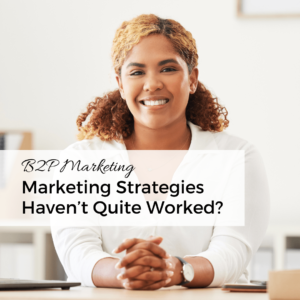Schedule a Free 360° Marketing Consultation
to Brainstorm Best Marketing Practices for Your Business

You’ve tried it all—B2B, B2C, social media platforms galore, and yet, something’s missing. Your marketing efforts seem to fall flat, and you can’t quite put your finger on why. If this sounds like you, it’s time to consider a different approach: Business-to-Professional (B2P) marketing.
Before we explore the intricacies of B2P, let’s address the elephant in the room: the disconnect you’ve been experiencing with traditional marketing models.
99% of the advice that you’ve been hearing about how to do marketing is designed only for entrepreneurs who sell to CONSUMERS. It works if you sell things to individuals for their personal use.
For example, you hear that you MUST be on TikTok and post more than once a day. Or that you need to create a Facebook Group. And then wonder why those haven’t given you as much success as they seem to for other people.
Or you hear about things like Account Based Marketing and think it just feels overly complicated and has been hard to enact in your business.
Or you hear that you need a FUNNEL … and can’t figure out how to craft those upsells and downsells and all of the followup email sequence just right, but it’s not quite working. (Hint: everyone who sells already has a funnel … it doesn’t mean what people try to make you think it means.)
You’ve been told to follow B2B or B2C strategies, but neither seems to fit your unique business needs.
Maybe it’s not you … maybe it’s that advice that you’re trying to follow.
I’m going to explore why, by explaining how the strategies need to differ between the different audiences.

B2B marketing is often associated with long sales cycles, complex buying processes, and a heavy focus on ROI. If you’ve been trying to apply these principles to your business but find them misaligned, it’s not your fault. B2B marketing is not a one-size-fits-all solution.
For instance, let’s say you’re a solopreneur offering specialized consulting services. It’s typical in a B2B setting to expect a long sales cycle – up to 12 to 18 months is very common. This is because most big corporations start planning next year’s budget EARLY this year, so if you want to have your product or service included in that budget planning, you need to start selling early, and then not expect to close any transaction until much, much later. During the interim, you would be keeping in touch with the prospect, providing whatever type of documentation or supporting materials they need along the way to help them “sell” their boss along the way, and generally just keep a positive relationship alive.
Long and complex.
Maybe you thought your prospects would need to fit into the B2B umbrella because they aren’t B2C. Yet in your business, maybe you find that the long sales cycles typical in B2B are not only unnecessary but actually detrimental to your business.
If your potential clients don’t actually fit into this box, they might not have the patience for multiple rounds of negotiations and approvals—they want solutions, they can make the decisions, and they want them now … and maybe you need B2P.
Creating valuable, relevant content to attract a clearly defined audience is crucial in B2B. But it’s not just about churning out blog posts; it’s about producing content that solves real business problems. For example, a well-researched whitepaper on industry trends could establish you as a thought leader and attract high-quality leads.
LinkedIn and Twitter are your go-to platforms here. While it might be tempting to jump on the Instagram bandwagon, remember that B2B clients are more likely to engage with in-depth, industry-specific content.
A tweet saying, “10% off on our consulting services! #DealoftheDay” is less likely to resonate with a B2B audience looking for long-term solutions.
What also isn’t likely to work is trying to get these people to join a Facebook Group. They don’t have enough time in their day to bother.
LinkedIn and Twitter are platforms where professionals seek industry insights, making them ideal for B2B marketing. On the other hand, TikTok and Instagram are more suited for B2C, where the focus is on lifestyle and entertainment … while your ideal prospect may be on those, they probably aren’t using them for work.
While the following isn’t an exhaustive guide, it offers key insights to help you make informed decisions about outsourcing versus in-house management of your B2B marketing tasks. Your choices will hinge on your current team’s capabilities and where you, as the business owner, need to focus to stay in your Zone of Genius.
This doesn’t ever mean that you have to do it all inhouse (and you should not), you just need to make sure that an internal team member is involved.

B2C marketing is all about emotional connections and quick sales. If you’ve been focusing on this model but find that it doesn’t quite resonate with your target audience, it’s time to reassess. Not every business benefits from a B2C approach.
For example, if you’re a personal trainer whose fitness clients are local entrepreneurs, you might find that emotional marketing tactics, like posting before-and-after photos, work well. But if you’re a financial consultant who works with local artists who hand-craft jewelry, your potential clients are likely looking for more than just emotional appeal—they want proof of your expertise … so a B2C model won’t fit.
Navigating the B2C landscape requires a keen understanding of the content that resonates with individual consumers; here’s a breakdown to guide your strategy.
TikTok has become a powerhouse for B2C marketing, especially for brands that target younger audiences. The platform’s short-form video content allows for creative storytelling, making it a go-to for B2C brands looking to engage consumers in a more dynamic way. However, it’s essential to understand your target audience and whether they are active on TikTok before diving in; even if your audience is there, TikTok may not be the right platform for you, and TikTok requires a lot of constant work to keep getting results … so only consider it if your best customers are there.

You’ve tried it all—B2B, B2C, social media platforms galore, and yet, something’s missing. Your marketing efforts seem to fall flat, and you can’t quite put your finger on why. If this sounds like you, it’s time to consider a different approach: Business-to-Professional (B2P) marketing.
Before we delve into the strategies that work for B2P, it’s crucial to identify who this approach is for. B2P marketing is particularly effective for businesses that have other small businesses as their client. Your clients might be:
For the most part, it’s professionals who have consumers as clients (or sometimes even have other small businesses as clients.) If you find yourself marketing to one of these categories, or if you’ve been struggling to see results with traditional B2B or B2C strategies, B2P marketing might be the missing piece of your marketing puzzle.
Now that we’ve identified the problem, let’s focus on the solution. Here are some strategies that have proven effective in the B2P sector.
Content is king, but not all content is created equal. For B2P, the focus should be on providing value—real, actionable insights that professionals can apply in their daily operations. Yet also things that they can consume relatively quickly.
Social media is not just about posting pretty pictures; it’s about building relationships. For B2P, LinkedIn and industry-specific forums are often more effective than Facebook or Instagram. And don’t expect them to join a Facebook Group just because you set one up … it better offer huge value for them to take the time to join, or especially participate.
LinkedIn, Facebook, and Instagram offer a mix of professional and personal content, making them ideal for B2P marketing. Twitter, on the other hand, is less effective for local businesses. A tweet saying, “Happy Hour at Joe’s Bar! #ThirstyThursday” might work for a B2C audience but is unlikely to resonate with a B2P audience looking for more substantial content.
TikTok has become a sensation for B2C, especially for brands targeting younger demographics. However, for B2P—where the focus is on individual professionals who are often looking for more in-depth, actionable content—TikTok generally misses the mark. TikTok’s fast-paced, entertainment-focused nature doesn’t lend itself well to the nuanced, value-driven content that B2P audiences typically seek. While you might find some professionals using TikTok for personal branding, it’s not the most effective platform for establishing professional credibility or offering the kind of detailed advice or solutions that B2P audiences value.
In the age of social media, email marketing often takes a backseat, but it’s a powerful tool for B2P.
One mistake many entrepreneurs make – no matter which type of marketing strategy they’re doing – is hiring a Virtual Assistant (VA) to implement tactics before having a solid strategy in place. While VAs are excellent for implementation, they’re not the right team for crafting a strategy. That’s where a Fractional CMO or marketing expert comes in—to set the strategy that your VA can then run with.
Schedule a Free 360° Marketing Consultation
to Brainstorm Best Marketing Practices for Your Business

Vicky is the CEO and Chief Creative Strategist of Vicky Wu Marketing. She draws from 30 years of experience at the CMO level, the CEO level, marketing for Fortune 500 companies and multi-million and multi-billion-dollar organizations, PLUS strategies learned helping startups and nonprofits with limited budgets … now focusing on providing SMBs with effective and efficient marketing strategies – giving them access to the same level of expertise as the really big guys with deep pockets, that they may not otherwise be able to access.
Get solid marketing strategies, designed for entrepreneurs on the track to 7-figures and beyond, right in your inbox.

